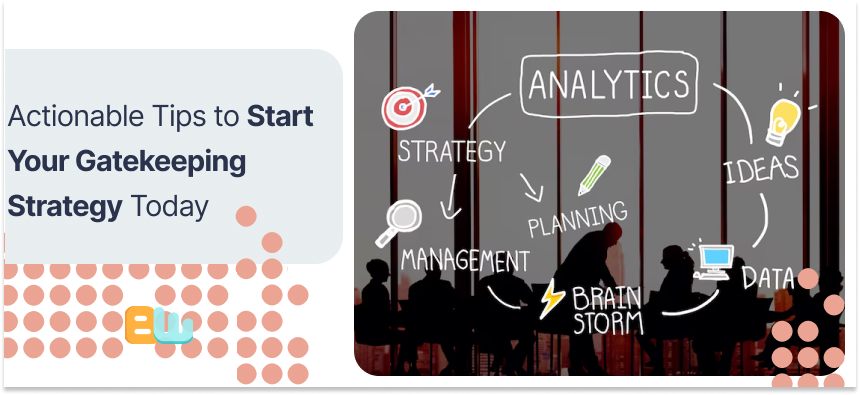
Is it difficult for your brand to stand out in the busy market of today? Gatekeeping, a tactic that initially appears illogical, may hold the key to the solution.
The majority of marketing advice concentrates on reaching a wider audience, yet intentional gatekeeping produces exclusivity, which is becoming more and more desirable. Restricting access to your products, services, or content can significantly boost demand and increase value if done correctly.
The results of my years of research into how well-known businesses use gatekeeping to increase engagement are indisputable: careful gatekeeping is effective. I’ll walk you through the process of putting these strategies into practice in this post.
Understanding Gatekeeping in Modern Marketing Landscapes

Gatekeeping has developed into an advanced marketing strategy that uses constrained availability to boost desire. Let’s study the significance of this for your brand.
What is Gatekeeping and Why It Matters Today
In marketing, gatekeeping refers to the deliberate restriction of who has access to your products, services, or content. Gatekeeping purposefully creates obstacles, in contrast to traditional marketing, which seeks to reach everyone.
These barriers can take many forms:
– Invitation-only access
– Waitlists for new products
– Members-only content
– Premium pricing tiers
– Limited-edition releases
Customers are overwhelmed with options in today’s crowded digital environment. Nothing feels unique when everything is accessible. This is precisely why gatekeeping has gained traction—it creates something increasingly rare: exclusivity.
Purchase intent and perceived value are directly raised by limited availability, according to research published in the Journal of Consumer Research. We desire something more when it isn’t accessible to everyone.
The Psychology Behind Exclusivity in Consumer Behavior
The power of gatekeeping is rooted in fundamental human psychology. We want things that are difficult for us to get.
The “scarcity principle,” which was initially recognized by psychologist Robert Cialdini, is the name given to this phenomenon. When possibilities are limited, they become more valuable to us. This explains why “limited time offers” and “while supplies last” messaging always motivate action.
Take Clubhouse, an audio-based social media site that started out with an invitation-only approach. Without using traditional promotion, the impossibility of just downloading and joining caused excitement between individuals looking for invites, which resulted in a huge amount of organic interest.
How Top Brands Successfully Implement Gatekeeping Tactics
Leading brands have mastered the art of gatekeeping without appearing elitist or unnecessarily restrictive.
Apple has perfected this balance. While their products are widely available, they maintain an ecosystem that creates natural barriers. Their exclusive software and high prices develop a unique user base that feels like they belong to something unique.
American Express has also long used “membership” positioning to turn what would be viewed as a drawback (not everyone is eligible) into an advantage (you’re a member of a select group).
The most important takeaway from these businesses is that gatekeeping needs to offer individuals who pass through the gates real value. Exclusivity without substance quickly backfires.
5 Powerful Ways Gatekeeping Creates Brand Value

Strategic gatekeeping isn’t just about saying “no” to potential customers—it’s about creating systems that build lasting value. Here are five proven approaches.
Building Perceived Scarcity Through Limited Access
Limited access drives demand when implemented thoughtfully. Nike’s limited-edition sneaker releases have transformed ordinary product launches into major events.
Their SNKRS app has become the gatekeeper for these exclusive drops, creating a community of devoted fans who regularly check for new releases. The scarcity is real—these products truly are limited—but Nike has built an entire experience around this limitation.
You can implement this approach by:
– Creating genuinely limited product runs
– Communicating clearly why quantities are limited
– Building anticipation before limited releases
– Documenting demand to strengthen future launches
The key is authenticity. Artificial scarcity that’s clearly a marketing ploy will damage trust rather than build it.
How Membership Models Drive Customer Loyalty
One-time buyers become devoted community members with a stake in the success of your company thanks to membership models.
Costco exemplifies this approach. Their membership fee serves as a gatekeeping mechanism that both generates revenue and creates psychological investment. Once consumers pay to join, they’re motivated to shop there to justify their membership.
Amazon Prime works similarly but adds substantial benefits that make the gates feel like a privilege rather than a barrier. Their subscription creates a “members-only” shopping experience with tangible benefits like faster shipping.
To implement membership models effectively:
– Ensure the benefits clearly outweigh the membership cost
– Create members-only features that enhance the core experience
– Regularly add new benefits to maintain perceived value
– Use membership data to improve personalization
Creating Brand Communities That Consumers Crave
Exclusive communities satisfy our deep human need for belonging while creating powerful marketing advantages.
Peloton has mastered community-based gatekeeping. Their hardware purchase requirement serves as the gate, but once inside, users gain access to a vibrant community that provides motivation, accountability, and social connection.
This approach works because the exclusivity serves a purpose beyond marketing—it ensures everyone in the community has skin in the game and similar goals.
Smaller brands can implement this by:
– Creating private social spaces for customers
– Hosting exclusive events for community members
– Facilitating connections between customers
– Sharing insider information within the community first
Leveraging FOMO: The Exclusivity Marketing Advantage
Fear of missing out (FOMO) is a powerful psychological trigger that gatekeeping naturally activates.
Streaming service HBO Max has leveraged this brilliantly with their same-day movie premieres. The limited window to watch new releases drives subscriptions from people who don’t want to miss cultural moments.
Similarly, pop-up shops and limited-time collaborations create urgency that motivates immediate action.
To ethically leverage FOMO:
– Set clear timelines for limited opportunities
– Provide genuine reasons for the limitations
– Create shareable moments that amplify visibility
– Follow through on end dates to maintain credibility
Pricing Strategies That Reinforce Brand Positioning
Strategic pricing creates natural gates that separate casual browsers from serious customers while reinforcing your brand’s positioning.
High prices are the main gatekeeping strategy used by luxury brands such as Hermès. Their renowned Birkin bags, which range in price from $9,000 to over $500,000, are not only pricey but also subject to allocation restrictions. The pricing is in line with their brand promise of outstanding expertise and exclusivity, which is why this strategy works.
For non-luxury brands, tiered pricing can create similar effects:
– Basic access for entry-level customers
– Premium tiers with substantive additional benefits
– Exclusive top tiers that provide white-glove service
– Limited-time pricing promotions that create urgency
Implementing Gatekeeping Without Alienating Your Audience

The greatest risk with gatekeeping strategies is creating resentment rather than desire. Here’s how to implement these approaches thoughtfully.
Finding the Balance Between Exclusivity and Accessibility
Effective gatekeeping requires a delicate balance. Too exclusive, and you limit growth; too accessible, and you lose the benefits of scarcity.
Spotify has navigated this balance expertly. Their freemium model provides basic access to everyone while reserving premium features for subscribers. This creates natural upsell opportunities without completely restricting the core service.
Consider these balancing strategies:
– Provide meaningful free experiences alongside premium options
– Create clear, achievable paths to accessing exclusive content
– Rotate which products or services receive the exclusivity treatment
– Use temporal gatekeeping (early access) rather than permanent restrictions
3 Ethical Considerations When Using Gatekeeping Strategies
Gatekeeping raises important ethical questions that brands must address proactively.
First, avoid discriminatory practices. Gates should be based on relevant factors like purchase history or engagement, not demographic characteristics.
Second, be transparent about your processes. If products are genuinely limited, explain why. If there’s a waitlist, share how it works.
Third, ensure proportional value. Whatever sits behind your gates must deliver value that justifies the additional effort, cost, or waiting time.
Everlane demonstrates ethical gatekeeping with their “Choose What You Pay” model for overstock items. This creates a form of price-based gatekeeping while being completely transparent about costs and reasoning.
Digital Tools That Enhance Strategic Gatekeeping Efforts
Modern technology provides sophisticated tools to implement gatekeeping without massive operational overhead.
Platforms such as Memberful and Patreon make it simple for authors to set up membership types with automated content access for access management.
Tools such as Shopify’s Launchpad created timed product drops with waitlists for restricted product releases.
For community building, Circle and Mighty Networks provide branded community spaces with flexible access controls.
For exclusive content, solutions like Teachable and Kajabi offer protected content areas with progressive unlocking capabilities.
The right technology makes gatekeeping feel premium rather than frustrating, creating smooth experiences for those who qualify for access.
Case Studies: Gatekeeping Success Stories Worth Learning From

Let’s examine brands that have mastered different approaches to strategic gatekeeping.
Luxury Brands: Masters of the Gatekeeping Approach
Luxury brands have historically led the way in gatekeeping strategies, but their approaches offer lessons for brands at every price point.
Rolex exemplifies supply-side gatekeeping. Their most coveted models have years-long waitlists not as a marketing gimmick but due to their commitment to production quality. This scarcity has transformed their watches into appreciating assets rather than depreciating purchases.
The lesson: When scarcity is tied to genuine quality concerns rather than artificial limitations, customers respect rather than resent the gates.
Chanel employs purchase history gatekeeping, offering their most exclusive bags only to customers with established relationships. This promotes brand loyalty and additional purchases.
The lesson is that giving devoted clients special access leads to strong motives for continued participation.
Tech Companies Using Waitlists to Generate Buzz
Technology companies have refined waitlist strategies into powerful marketing tools.
Gmail’s invitation-only beta generated a lot of excitement when it first launched in 2004. Because there were only a certain number of invites sent to each user, early adopters became gatekeepers themselves.
The lesson: Empowering your community to extend invitations transforms gatekeeping from restriction to shared privilege.
More recently, AI tool Midjourney used a Discord-based waitlist system during their beta. This created natural community building as people waited for access, while giving the company time to scale their infrastructure.
The lesson: Waitlists can serve dual purposes—creating demand while solving operational challenges.
How Membership-Only Retailers Maintain Customer Excitement
Membership retailers have pioneered ways to keep excitement high within their gated communities.
Through the rotation of limited-edition products, Costco’s “treasure hunt” merchandising strategy generates excitement. Regular visits are encouraged because members never know what unique objects they’ll find.
The lesson: Even within gated experiences, creating internal scarcity drives engagement.
The wine club Winc uses personalization to make their membership feel individually tailored. Their preference algorithm creates unique monthly selections, making the subscription feel like a personalized service rather than a mass product.
The lesson: Personalization makes gates feel like filters that improve the customer experience rather than arbitrary barriers.
Measuring the ROI of Your Gatekeeping Marketing Strategy

Like any marketing approach, gatekeeping strategies must demonstrate business value through careful measurement.
Key Performance Indicators for Exclusivity Campaigns
Traditional marketing metrics often focus on maximizing reach, but gatekeeping requires different success measures.
Key metrics to track include:
– Conversion rate from waitlist to purchase
– Customer lifetime value of members vs. non-members
– Renewal rates for subscription services
– Premium tier adoption percentages
– Word-of-mouth referral rates
– Social mention sentiment
– Time to capacity for limited offerings
Starbucks’ Rewards program demonstrates excellent measurement practices. They track not just membership numbers but incremental spending from members, frequency of visits, and mobile order adoption.
When to Pivot: Recognizing Failing Gatekeeping Tactics
Not all gatekeeping strategies succeed. Watch for these warning signs that indicate a need to pivot:
– High abandonment rates during the access process
– Declining waitlist conversion rates
– Negative sentiment in social conversations
– Decreasing referrals from existing members
– Competitors successfully targeting your excluded customers
Google+ provides a cautionary tale. Their initial invitation-only approach generated interest, but the platform failed to provide sufficient value once users gained access. This led to high initial interest followed by rapid abandonment.
The lesson: Gates create expectations that your product or service must fulfill.
Combining Data Analytics With Exclusivity Marketing
Modern analytics tools allow for sophisticated optimization of gatekeeping strategies.
Netflix exemplifies data-driven gatekeeping through their content licensing decisions. They analyze viewing patterns to determine which content deserves exclusive development investment, creating shows that serve as subscription drivers.
To implement similar approaches:
– Segment customers based on response to exclusive offers
– A/B test different gatekeeping messaging
– Track which exclusive benefits drive the most engagement
– Monitor competitor responses to your gatekeeping
– Analyze seasonal patterns in exclusivity effectiveness
The Future of Gatekeeping in Digital Marketing

The gatekeeping landscape continues to evolve. Here’s what to watch for.
How AI and Personalization Are Changing Exclusivity
Artificial intelligence is transforming gatekeeping from binary (in/out) to highly personalized experiences.
Personalized gatekeeping uses behavioral data to create individual paths to exclusive experiences. Nowadays, streaming services like Spotify generate “Daily Mix” playlists that are algorithmically customized and feel special since they are exclusively yours.
Similar to this, companies are using AI to find high-potential clients sooner and provide them with faster access to special advantages based on lifetime value estimates rather than just present expenses.
Will Gatekeeping Survive in the Age of Transparency?
As consumers demand greater transparency, gatekeeping strategies must adapt.
The most successful modern approaches combine exclusivity with clear explanations of why certain limitations exist. When Tesla launched the Model 3, they were transparent about their production constraints while creating a reservation system that built anticipation.
We’re also seeing hybrid models emerge that combine open access to basic offerings with gated premium experiences, allowing brands to balance growth with exclusivity.
Emerging Trends in Exclusive Customer Experiences
Several emerging trends are reshaping gatekeeping strategies:
Token-gated experiences using NFTs and blockchain technology are creating new ownership-based access models.
Exclusion at scale is made possible by micro-communities within larger corporations; Sephora, for example, has established communities with different degrees of access.
Collaborative exclusivity, where brands partner to create experiences available only to customers of both companies, is becoming popular.
Actionable Tips to Start Your Gatekeeping Strategy Today

Ready to implement gatekeeping in your marketing? Here’s how to begin.
Quick-Start Guide for Small Business Gatekeeping
Small businesses can implement effective gatekeeping with limited resources:
1. Start with a simple email list segmentation that provides exclusive content to your most engaged subscribers.
2. Create a basic membership tier that offers early access to new products or services.
3. Launch limited-quantity product runs to test demand without major inventory risks.
4. Host invitation-only virtual events for top customers to build community.
5. Implement a referral program that rewards existing customers for bringing in new ones.
The key is starting small and being consistent. Even modest exclusivity can drive significant engagement when well-executed.
Tools and Resources for Managing Exclusive Offerings
Several affordable tools can help manage gatekeeping initiatives:
– ConvertKit for email segmentation and automated sequences
– Eventbrite for managing limited-capacity events
– Shopify apps like “Locksmith” for creating protected shopping areas
– Patreon for membership content delivery
– Bonjoro for personalized video messages to VIP customers
For learning resources, follow gatekeeping pioneers like Tiffany & Co., Supreme, and Glossier to observe their strategies in action.
Building Your First Members-Only Marketing Campaign
To create your first members-only campaign:
1. Identify a genuine benefit you can offer exclusively to a segment of customers.
2. Determine the qualifying criteria—spending level, engagement history, or opt-in requirement.
3. Create a clear name and identity for the program that aligns with your brand.
4. Develop a communication plan that builds anticipation before launch.
5. Design a simple onboarding experience that immediately delivers value.
6. Establish measurement systems to track impact.
7. Gather feedback early to refine the experience.
Keep in mind that your initial campaign doesn’t have to be flawless. By starting small, you can discover what is aligned with your target audience.
Final Thoughts on Strategic Gatekeeping
Creating meaningful experiences that benefit your business and your most valuable consumers is the key to effective gatekeeping, not randomly limiting access.
These tactics, when used carefully, produce strong distinctiveness in crowded markets. They transform ordinary products into coveted experiences and convert casual customers into passionate advocates.
The most successful gatekeeping approaches share a common trait: they make those inside the gates genuinely glad they made it through. When exclusivity delivers on its promises, your marketing becomes something much more valuable—a relationship built on mutual benefit.
What gatekeeping strategies might work for your brand? The answer lies in understanding what your most valuable customers truly want that others might not appreciate. Find that, and you’ve discovered your gate.
